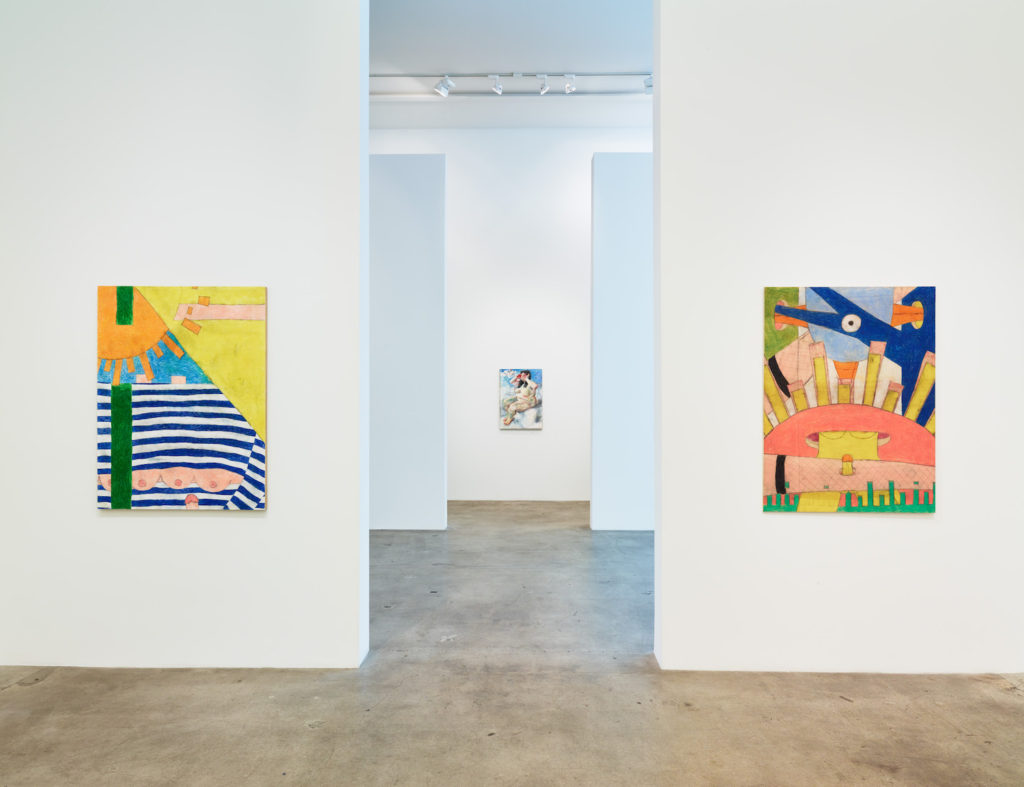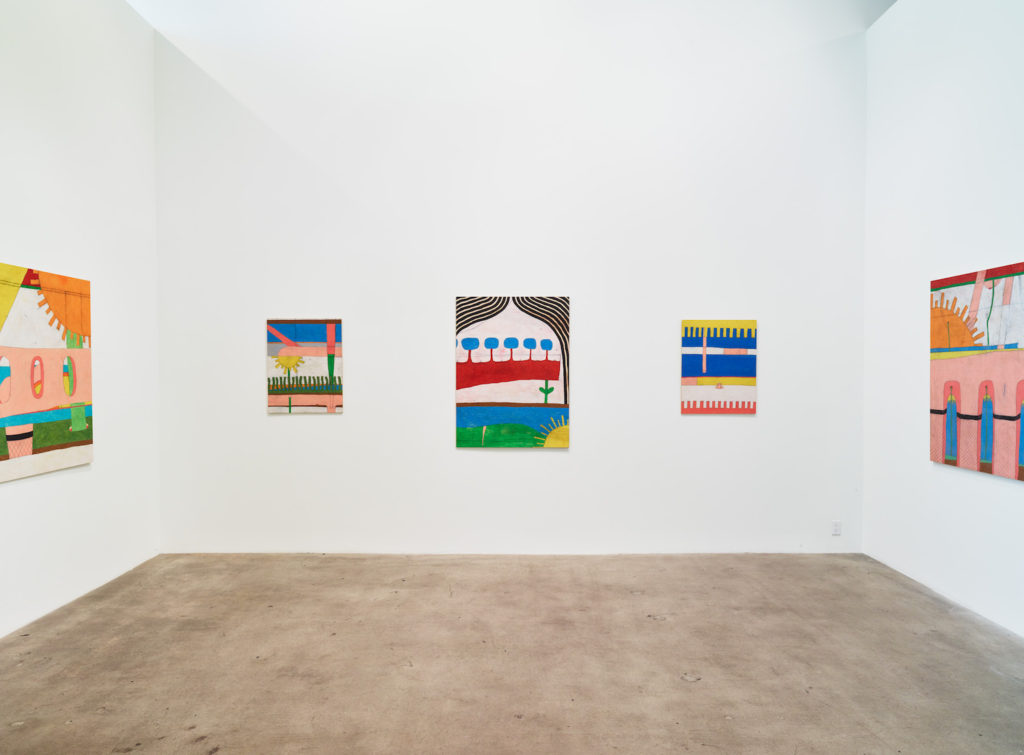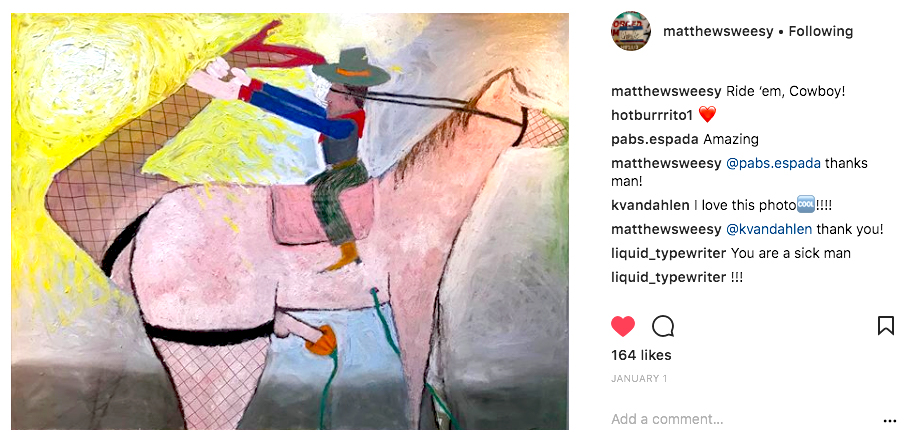
Matthew Sweesy, Nocturnes, Installation view at Diane Rosenstein Gallery, LA, Image courtesy of the artist and gallery, 2018
On the occasion of Nocturnes, a solo exhibition at Diane Rosenstein Gallery in LA, Katy Diamond Hamer sat down with artist Matthew Sweesy. They discussed his inspirations, influences and the unforseen physical challenges accepted head-on while making this body of work. Sweesy is an LA based artist working in a particular figurative tradition turned on its head. He uses various media —thus far all two-dimensional— to explore the body through real and imagined orifices, interacting with actual and psychological space.
Matthew Sweesy: I like that you chose the words spatial dissection, as I am usually operating from a place where I want to more completely understand myself, my environment and the boundaries between them, both physically and psychologically. Are these boundaries real, and if so can they be adjusted, or even eliminated and what are the potential consequences of these scenarios? These boundaries shift as I move more deeply into a painting, or rather a meditation on the subjects I am painting. This usually results in an exploration that approaches a visual chaos or confusion in terms of what I usually think of as traditional, or familiar figurative or landscape images.
During this process, my consciousness is transported into the anatomy of another’s, perhaps a flower, the sun, a bird, a lover or an enemy. Line workings are often functions of these emotional positioning systems. The resulting narrative, which is often deeply personal, manifests at the crossroads of my hopes and fears. Through the corresponding abstraction and reconfiguration, I am moved into a more clear understanding of how I want to be in the world.
For example, I take, say an arm, and cut apart not the actual arm, but the idea of the arm. In this process, questions arise possibly along the lines of, “Does the sun have arms? What if the sun has my arms and my arms are the sun’s rays?” I admit and am comfortable with the notion that this sounds very childish. However, in the reassembly that unfolds by answering these questions, identities begins to blur, empathy grows and a feeling of connectedness increases. I feel I become part of the gear-workings of the universe instead of isolated within my own anatomy. Such feelings are central to why I create. It is medicine for me and I’m endlessly fascinated by the possibilities of learning and experiencing new ideas and relationships which keep me from sinking into the jaws of a black-hole in my chest.
KDH: There is a sexuality to your work, however I wouldn’t call it overt or distasteful. It seems to be more about the exploration of forms and possibilities rather than shock. Can you say more about this?
MS: The sexuality in my work is a product of my play with form and ideas. For example, my painting, “Ride ‘em, Cowboy,” [not in Nocturnes] may be distasteful to some and features a horse in fishnet stockings having intercourse with a flower rising from the plains. Simultaneously, a backward facing cowboy sits, blindfolded by the reigns, upon the saddle, cranking upward or rather prying open one of the horse’s hind legs, presumably for it to be penetrated, perhaps by the radiant, probing sun which pulses above. I give myself the liberty to explore the consequences of manifesting such impossible sexual couplings and their corresponding off-spring, which can only exist in the mind. I have little interest in exercising permutations of lust and kink for the sake of overt shock.
What transpires for me from following such thoughts through is further questions and iterations that call into question the Mandelbrotian off-spring of a horse and a flower. An ancestor of the flower may be the rotted flesh of the lover buried in the ground beneath it. As this tree of thought grows, so does the notion of connectedness and ultimately, all things become fractals of self and vice versa. If I can get to this place through my playful drawing the interwoven fabric of the universe is alive in my consciousness and I am more capable of empathy and compassion, fears subside and life is better.
On one level this all sounds so absurd. That’s ok with me. It can be absurd, but if in its absurdity it ever so slightly cracks open a new idea of compassion or living more freely and truthfully, I couldn’t be happier. The work only wants to be a catalyst, not a perfectly rendered aesthetic to be adored. I sometimes feel like a psychological alchemist. Depending on the subject at hand, it may from time to time require the use of an erect penis.
KDH: The press release for Nocturnes, talks about the ‘basic elements of a child’s drawing’ in reference to some of the motifs you use. Obviously the elements, in this case sunshine, grass, and blue sky, on their own aren’t child-like but perhaps refer to your hand or the fact that you are using colored pencil for this particular body of work. How do you see your work in dialogue with that of a child or your own inner child?
MS: My mother recently sold the home I grew up in. When I was back in Iowa to help her prepare for the sale, we came across all the drawings my sister and I made as children. It had been decades since I had seen them. I was struck by the repetition of imagery in the drawings such as you mentioned, the sun, a bird, a swing-set, the sky, clouds, grass. The multitude of them, seen one after the other, made me see these subjects with a resurgence of wonder and reverence. I wanted to know what it might feel like to retread this ground, to meet the same imagery from the other side of experience and discover which truths I’ve continued to carry with me about how I see and experience the world.
The choice of colored pencil on wood seemed like a fair and proportional scaling up from the crayon and paper is used as a child. The size of the wood, 48×36 inches demanded a physicality and patience that slowed down the process of drawing and forced me to meditate on the subjects which debated and negotiated space with themes of adulthood.
KDH: I could easily think of your work, subjectively, as being made by the great-grandchild of Philip Guston. There is something referential of the late artist’s sensibility, specifically his later work. You mention being influenced by Louise Bourgeois but do you feel connected to Guston at all?
MS: The first Philip Guston painting I recall seeing was on the cover of a poetry anthology from a class I was taking on anti-lyric poetry. I was about 20 years old. It was “The Source”. I still have the book, From the Other Side of the Century: A New American Poetry 1960-1990 and refer to it on occasion. However, the image of the painting has continued to burn bright in my mind. At the time I was much more into writing poetry than visual art. The fact that this work was on a book so influential to me seems like a fitting seed to the eventual overlap between my writing and drawing.
I believe the painting may be of Guston’s wife, or is it the sun on the ocean horizon? It’s both. The confusion of these subjects, or co-existence of their locations, i.e., the world of human emotions physically commingling with, or occupying the energy and fire of the sun speak loudly to me in terms of shedding the boundaries I mentioned in previously. Even her eyes cast beams of light across the ocean surface like the sun does.
His work plays with form in a deliberate, contextual way which excites and sustains my curiosity. I find his playfulness so much more interesting than the surrealists, which can feel arbitrary and fleeting to me. The surrealist works taught me that it is okay to have freedom with form, to bend the rules, but Guston employs them where I feel the emotional rubber of the mind meets the road of the heart. I can really feel these paintings. They teach me so much. In a work like, “Monument” I learn so much about how physics and potential energy can translate a static image into so much noise and motion. I can’t get enough of this!

Matthew Sweesy, On view in Nocturnes, Diane Rosenstein Gallery, LA, Images courtesy the artist and gallery, 2018
KDH: This is your second solo exhibition this year but prior to 2016, you hadn’t shown your work. It’s exciting to think of someone without an exhibition history making waves. Can you speak a little about this and how you arrived at producing artwork?
MS: Thank you. I am grateful for these recent shows. It can appear that they have come out of nowhere, and to a degree that is true. It has only been over the last several years that I have been actively sharing my work, meeting other artists and visiting exhibitions regularly. Prior to that, my work was primarily shown to friends or maybe just kept to myself. Until my mid 30s I spent most of my creative time as a writer. Whenever people asked me about my writing I would explain to them that they were more like static animations than poems. At some point along the way, I thought to myself, you’re always talking about poems being like drawings, why don’t you draw the poems you see your head? With that said, I feel like I’ve been drawing my whole life, so it has actually taken quite a while to get where I am.
KDH: What was it like producing the work for Nocturnes?
MS: Painful, euphoric, nostalgic and fulfilling. Physically, it was painful. I mildly injured my wrist, shoulder and a finger from drawing too hard. I moved from 1/4” panel to 1/2″ panel because I felt like I was going to break through the wood. However, the physicality of the drawings was also what gave me the most pleasure. Sometimes I didn’t sharpen the pencils, but instead pushed down hard enough for the flattened pigment to come through and at the same time further smooth, or create indentions in the wood. It became clear to me in the process if these same drawings were made on paper on a smaller scale, or even the same scale with paint, their center of gravity would be missing. What they needed to be would fall apart.
I previously mentioned music as a great influence, or fuel for my imagination and work. Prokofiev’s piano sonatas and Chopin’s Nocturnes were a direct influence on these works. One or the other, and sometimes both at the same time, were always playing while I was drawing. My drawing hand loves this music. I think it may have a tiny ear on it somewhere I haven’t found yet that eats music to stay alive. I am pretty sure I would not have the same relationship with music if I did not encounter Arthur Schopenhauer’s writing on music while I was a cadet at West Point. What I learned from him has stuck with me and helped provide the necessary scaffolding for my visions. The manner in which he corresponds with the varying masses of the earth and the varied plant, animal and human life forms of the universe to the spectrum of bass and soprano truly gave me a new set of eyes. I was not gifted with any musical talents, but always felt an affinity with the piano. To be able to draw on that rectangular canvas of sound is a dream to me. Since I can’t do that, I thought I’d honor my dream by calling my show “Nocturnes.” Each of the pieces began with an image of the sun in place of a treble clef.
Katy Diamond Hamer is the Founding Editor of Eyes Towards the Dove a platform on contemporary art and culture. She writes for several publications and has done public speaking on numerous occasions. For more of her writing and art life travels, follow her on Instagram @katyhamer


